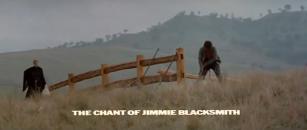 2761930044962898534.jpg
2761930044962898534.jpg
 2761930044962898534.jpg
2761930044962898534.jpg
Based on real events that occurred in Australia at the turn of the century and adapted from Thomas Keneally's novel, The Chant of Jimmie Blacksmith concerns a young man of Aboriginal and European heritage who has been raised by missionaries. A hard and reliable worker, Jimmie is employed on a property in central-western New South Wales. Hoping to achieve assimiliation into white society, Jimmy marries a white girl, but instead this only increases the loathing and ridicule directed at him. In the winter of 1900, an argument ensues between Jimmy and the owner of the property, which leads to Jimmie and his uncle horrifically killing most of the man's family. Jimmie subsequently takes to the bush with his wife, baby, and younger brother, Mort. Pursued by the police and vigilante farmers, Jimmie sends his wife back with a message: 'tell them I've declared war.' He and Mort kill again, but the younger brother becomes increasingly troubled by their actions. Jimmie eventually goes on alone until his inevitable capture and hanging.
Considered one of Australia's key films of the 1970s, The Chant of Jimmie Blacksmith tells the story primarily from the position of its Aboriginal protagonists, which some critics argue is controversial, as neither the writer nor the director is Aboriginal. Powerfully confronting, particularly with regard to the murder of the family (which includes women, teenage girls, and a baby), the narrative was one of the first to shift away from the presentation of Aboriginal people as noble savages and/or victims and to attack the myth that there was no Aboriginal resistance to white settlement.
Romaine Moreton (Screen Australia) argues that The Chant of Jimmie Blacksmith is still strictly organised in terms of 'us' and 'them' or 'non-Aborigine' and 'Aborigine' and, while true to the era before Federation, would have been told differently by an Indigenous filmmaker. Though Tom Keneally believes that he too would have written the novel differently today, saying, 'It would be insensitive to write from that point-of-view now', the 'other' viewpoint still provides a powerful and confronting narrative.
 The Films of Fred Schepisi
United States of America (USA)
:
University Press of Mississippi
,
2021
24570791
2021
multi chapter work
criticism
The Films of Fred Schepisi
United States of America (USA)
:
University Press of Mississippi
,
2021
24570791
2021
multi chapter work
criticism
'Fred Schepisi is one of the crucial names associated with the revival of the Australian film industry in the 1970s. The Films of Fred Schepisi traces the lead-up to his critical successes in feature filmmaking, via his earlier award-winning success as a producer in advertising commercials in the 1960s and the setting up of his own company. Unlike some directors, he derived from this experience a sure sense of the commercial aspects of filmmaking, as well as its aesthetic considerations. The volume also considers stories of his early education in a Catholic seminary, which he drew on in his semiautobiographical film, The Devil's Playground, the success of which launched him as an exciting new feature director.
'The volume expands on Schepisi's success story to chart his development as a director in demand in other countries, notably in the US and the UK, as well as continuing to make major films in Australia. Brian McFarlane argues that Schepisi's career is symptomatic of Australian directors who have made their presences felt on the international stage. Whereas other key directors of the Australian film revival, such as Peter Weir and Bruce Beresford, have been the subject of book-length critical studies, Schepisi's career has not to-date been so explored. McFarlane takes a critical account of Schepisi's film output-including such standouts as The Chant of Jimmie Blacksmith, Plenty, Roxanne, Six Degrees of Separation, Mr. Baseball, and Last Orders-and he augments analysis with interviews with the director. By discussing the production histories and both critical and popular receptions, McFarlane's study shines a new light on Schepisi's work and his rise to prominence in the global film industry.' (Publication summary)
'Fred Schepisi's 'The Chant of Jimmie Blacksmith' (1978), an adaptation of Thomas Keneally's 1972 novel of the same name, is an incendiary film from the Australian New Wave that attempts to give voice to aspects of the nation's violent history. With its then-sizeable A$1.2 million budget, the film was a commercial failure despite playing at the Cannes Film Festival to critical acclaim, and has continued to court controversy.'
Source: Abstract.
 The Chant of Jimmie Blacksmith
Strawberry Hills
:
Currency Press
National Film and Sound Archive
,
2008
Z1491067
2008
single work
criticism
The Chant of Jimmie Blacksmith
Strawberry Hills
:
Currency Press
National Film and Sound Archive
,
2008
Z1491067
2008
single work
criticism
'Set in central-western New South Wales in the 1890s, Fred Schepisi’s film of Thomas Keneally’s award-winning novel is a powerful and confronting story of a black man’s revenge against an unjust and intolerant society.
'Raised by missionaries, Jimmie Blacksmith, a young half-caste Aboriginal man, is poignantly caught between the ways of his black forefathers and those of the white society to which he aspires. Exploited by his boss and betrayed by his [white] wife, he declares war on his white employers and goes on a violent killing spree.
'The Chant of Jimmie Blacksmith was one of the most significant films of the 1970s ‘renaissance’. It was the first Australian feature in which the whole story is told from an Aboriginal perspective and it broke new ground in dealing with one of the most tragic aspects of Australian history: the racist treatment of the Aboriginal population. The spectre of the violent and vengeful black had barely been touched upon and the depth of rage that the film put on screen was unprecedented in Australian film at the time.' (Publication summary)